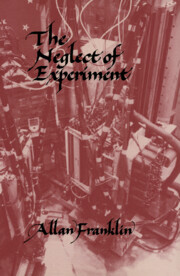Book contents
- Frontmatter
- Contents
- Acknowledgments
- List of abbreviations
- Introduction
- 1 The discovery of parity nonconservation
- 2 The nondiscovery of parity nonconservation
- 3 CP or not CP
- 4 The role of experiment
- 5 Do experiments tell us about the world?
- 6 The epistemology of experiment
- 7 The epistemology of experiment: case studies
- 8 Forging, cooking, trimming, and riding on the bandwagon: fraud in science
- Conclusion
- Notes
- Index
7 - The epistemology of experiment: case studies
Published online by Cambridge University Press: 15 December 2009
- Frontmatter
- Contents
- Acknowledgments
- List of abbreviations
- Introduction
- 1 The discovery of parity nonconservation
- 2 The nondiscovery of parity nonconservation
- 3 CP or not CP
- 4 The role of experiment
- 5 Do experiments tell us about the world?
- 6 The epistemology of experiment
- 7 The epistemology of experiment: case studies
- 8 Forging, cooking, trimming, and riding on the bandwagon: fraud in science
- Conclusion
- Notes
- Index
Summary
In the previous chapter I argued that there is an epistemology of experiment, a set of strategies that are used to provide rational belief in an experimental result. These strategies distinguish between a valid observation or measurement and an artifact created by the apparatus. One such strategy, suggested by Hacking, is intervention. Hacking's example involves use of the microscope, with the experimenter “intervening” (i.e., staining, injecting fluid) and in other ways manipulating the object under observation. This is a special case of a more general strategy in which we predict what will be observed if the apparatus is working properly or is working as we expect it to. When the observation is made, we increase our belief in the proper operation of the apparatus and in its results. Hacking also suggests that we believe in an observation if it can be made using “different” microscopes (i.e., optical, polarizing, phase-contrast, etc.) or if it is independently confirmed. If the apparatus is based on a well-corroborated theory, we also have good reason to trust its results. Even without such a theory we can validate observations. Sometimes the phenomena themselves provide such evidence. The observations of the moons of Jupiter by Galileo were extremely unlikely to have been artifacts of the telescope, as suggested by Cremonini, because they appeared to represent a consistent planetary system and even obeyed Kepler's Third Law (R3/T2 = constant).
If all plausible sources of error and all alternative explanations can be eliminated, then an observation is valid.
- Type
- Chapter
- Information
- The Neglect of Experiment , pp. 192 - 225Publisher: Cambridge University PressPrint publication year: 1986



